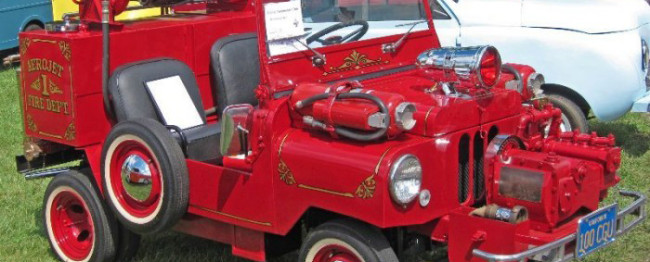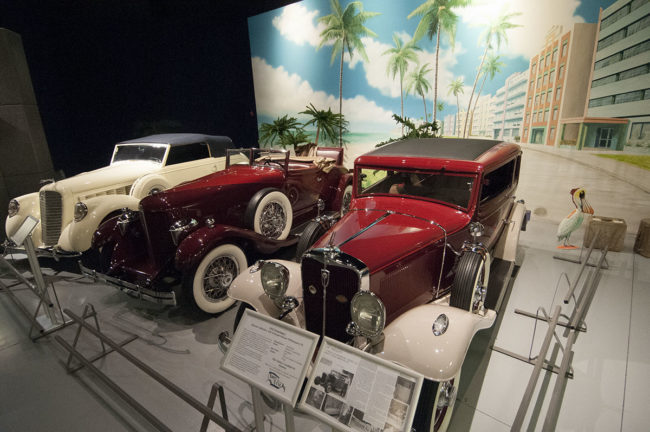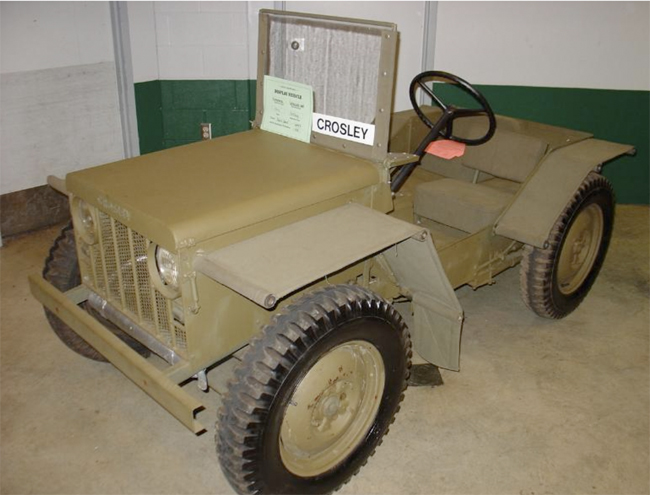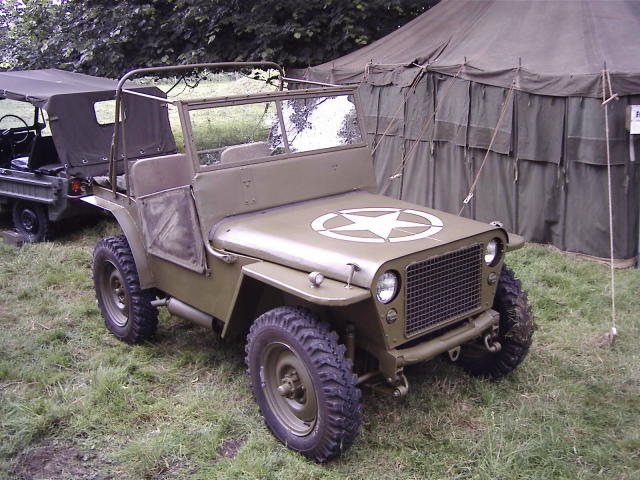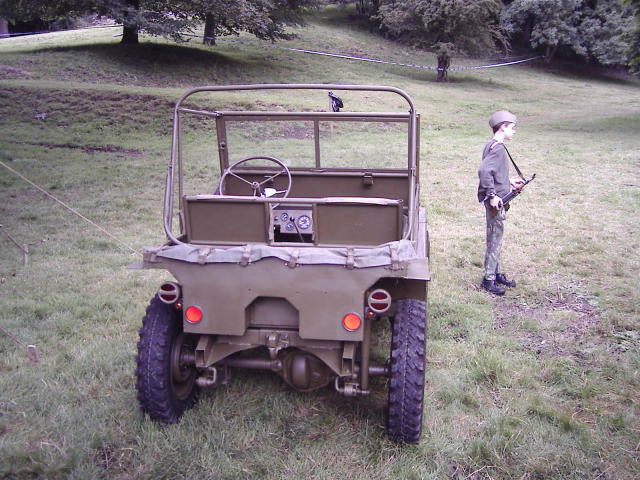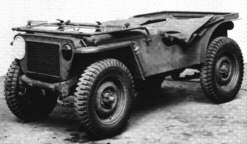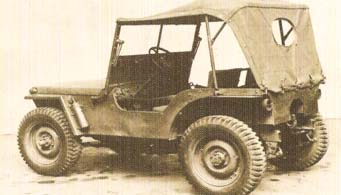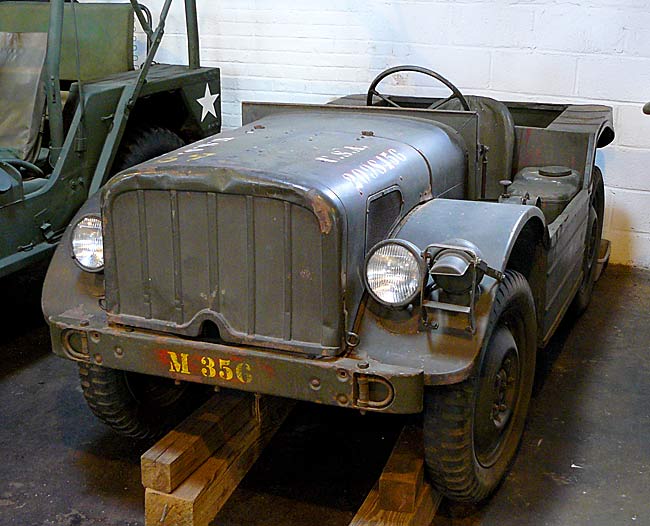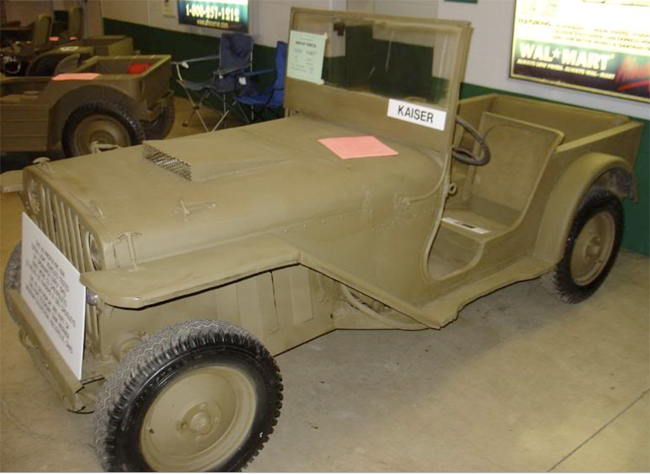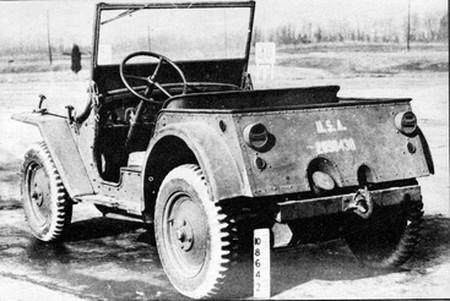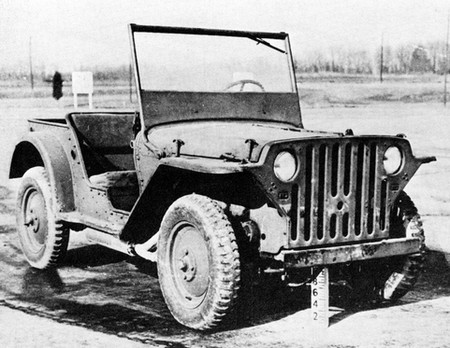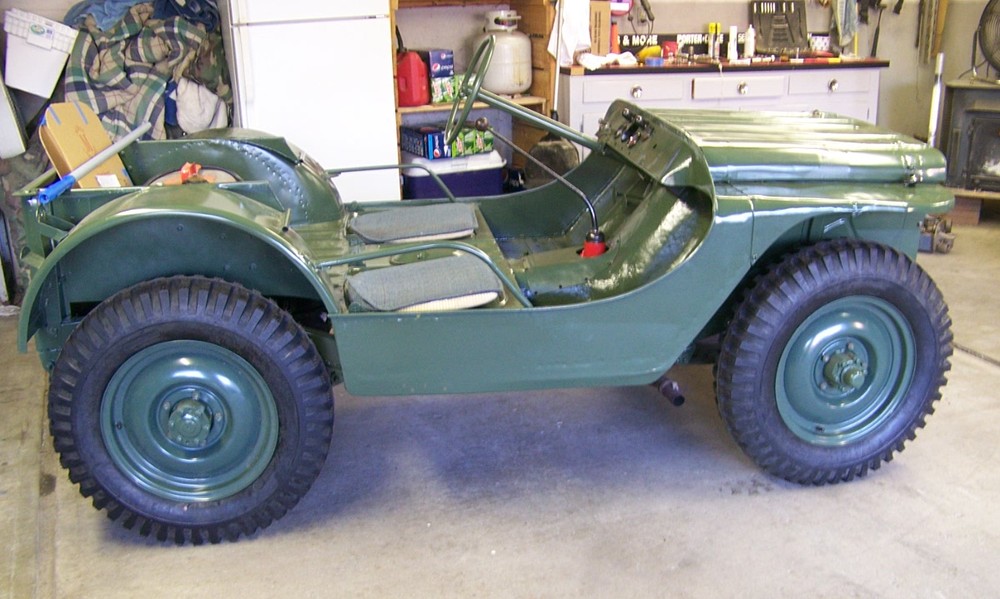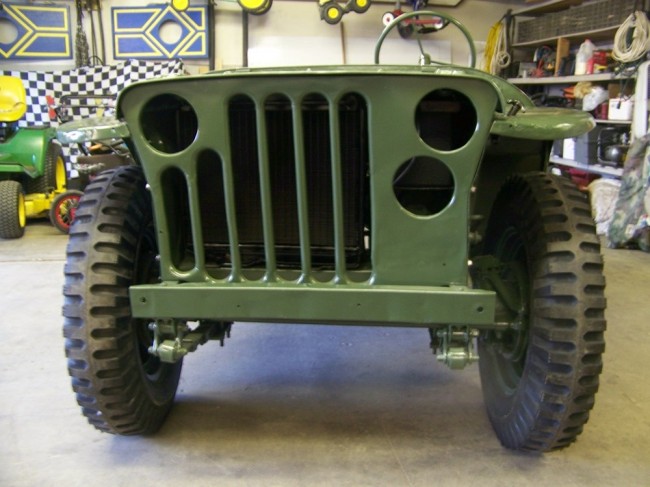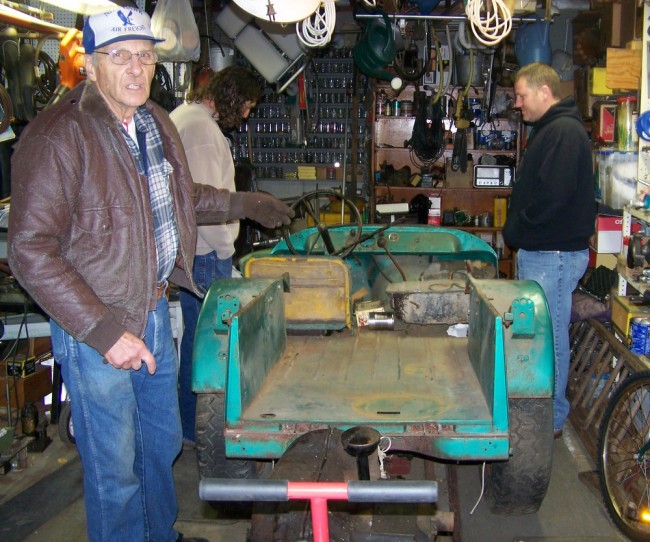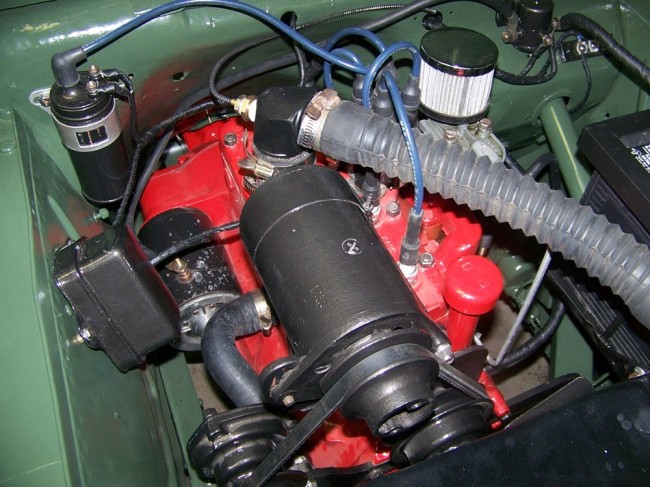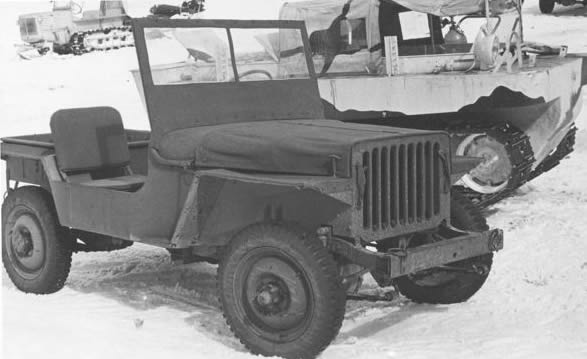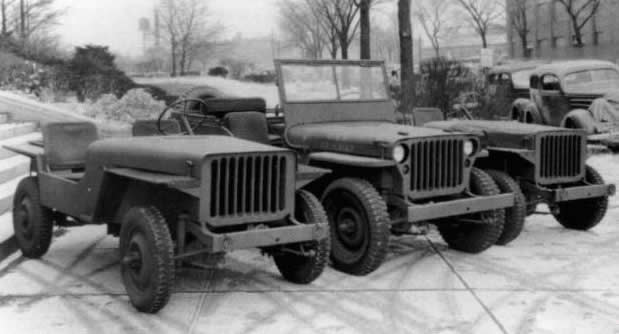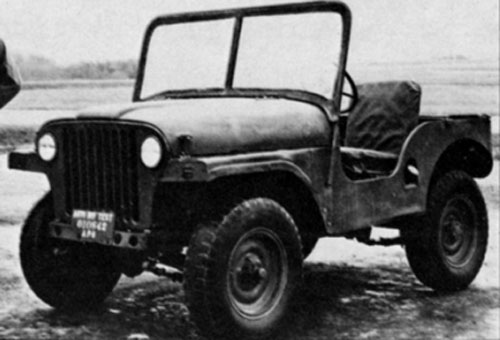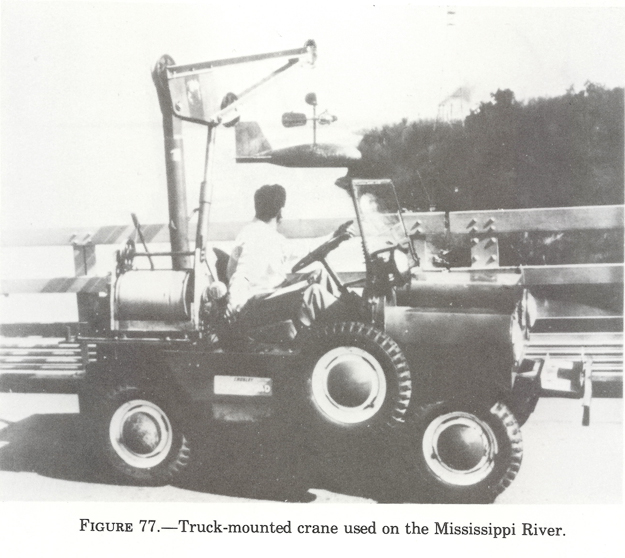This appears to be a variant of the Crosley Pup (see post from Jan 1). The size, the front end and the wheels look similar. The fenders are rounded. Possibly it is a prototype?
Crosley Research Archives
More on the Crosley “Pup” Jeep
UPDATE: The mystery Crosely at the bottom of the post has been identified as a Crosley Bull Pup thanks to L.C. Odin.
For those who haven’t read the article I posted on the lightweight jeeps a few years ago, Crosley built ‘extra-light weight’ four wheel drive vehicles called the CT-3 Pup and marketed to the military in 1942. The Pup had a 2-cylinder 13hp engine air cooled motor and weighed 1125 lbs. What I didn’t know was that a slightly different ‘hi hood’ version of the Crosley Pup was also built. More about that in a moment.
The issue of the Pup came to my attention yesterday because Marc forwarded me a great photo of a CT-3 Pup being loaded onto US Navy Bomber May 5, 1942, on eBay.
View all the information on ebay
According to Hemmings thirty-seven Crosley Pups were built before the idea was abandoned, at least in part, due to some weak parts. As in the photo above, here’s another look at the ‘classic’ version which you can view at Mighty Eight Air Force Museum in Pooler, Ga. (more pics of it here) and check out these fantastic detail photos at the Comancheclub.
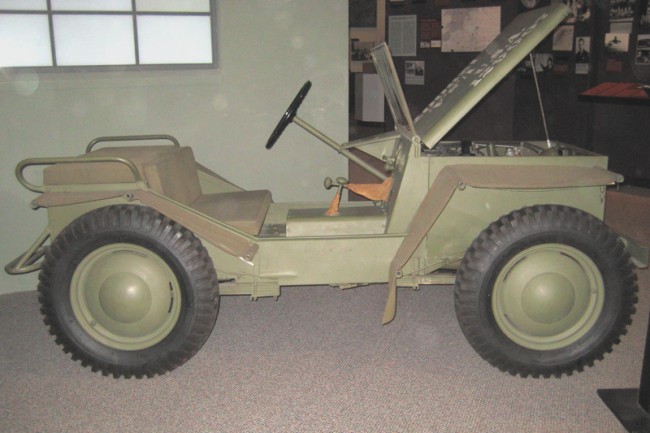 What makes the Crosley Pup jeep more interesting is that I discovered the following photos taken at the Cincinnati History Museum (Interesting note: the Museum offered a history program on Powel & Lewis Crosley in 2013) of a version of the Crosley that seems to have been ignored.
What makes the Crosley Pup jeep more interesting is that I discovered the following photos taken at the Cincinnati History Museum (Interesting note: the Museum offered a history program on Powel & Lewis Crosley in 2013) of a version of the Crosley that seems to have been ignored.
UPDATE: This has been identified as the Crosley Bull Pup. See L.C. Odin’s comment for more info .(Photos taken by Nicholas Massa)?
Crosley Fire Jeep at Hemmings
John forwarded this great article about the Crosely Fire Jeep, whose restoration was revealed at the Crosley’s Annual Meeting. See all the pictures and info at Hemmings.
Wed. May 22nd: Old Cars and Chocolate Shots
<– Day 18 – Tues. May 21st: Food and Jeep Rides | Trip Overview | Day 20 – Thurs. May 23rd: And Then it Started Raining at the Worst Time –>
On Wednesday we spent the day touring Hershey.
We started out our morning in Hershey, Pennsylvania, by driving to the Antique Automobile Club of America’s museum (aka: AACA). It was Brian who first suggested we visit it. The museum is actually two museums, the AACA’s collection uses the upper two floors and the Museum of Bus Transportation is on the bottom floor.

The Kissmobile was gone when we left the museum, so I was glad we stopped for a picture before we went inside.
The contrast between the two museums was interesting. The AACA’s exhibits are highly crafted. The volume of vehicles they show isn’t large, but each car is is placed within a context. Even the colors seemed coordinated with the backgrounds. Here are some pics of the AACA.
The Lightweights: Ford, Crosley, Willys, Kaiser, Chev, Nuffield, & Jeep
During World War II, trying to get vehicles, especially Jeeps, onto the ground where military personnel could use them was of paramount importance for obvious reasons. But, how to accomplish that goal was less clear. A variety of strategies were used. One idea that was opened up to bids by companies was a program to create an air-droppable Jeep, a lightweight jeep-like vehicle known as extra lights (EL) or lightweight jeeps or jeeplets that could be boxed and flown into areas where they were needed.
Similar to the original jeep prototype program, where multiple companies (in that case Bantam, Ford and Willys) submitted prototypes and pilots for review and testing, during World War II the military announced their lightweight jeep program and welcomed designs from a variety of manufacturers.
This program resulted in a variety of different vehicles that have been showcased across the web, mostly through old photos. In the article below I organize them using newer photos (whenever possible) to provide the most up-to-date look at most of these vehicles (I don’t have pics of all versions of every vehicle). For a fuller story of the history behind the lightweights, check out this 1977 article from Hemmings.
The image below shows a photo taken by Patrick Coovert in 2008 at Hallsville, Ohio. In order, from left to right are a CT3 Crosley Pup, the Chevrolet Extra Light (CEL), Willys WAC (Willys Air Cooled), and a Kaiser Extra Light (KEL). These are just a few of the jeeps developed.
1. THE LIGHTWEIGHT CROSLEYS: (More info on the Pup here)
CT-3 Pup: According to Hemmings, 36 Crosley CT-3 Pups were built during 1942 and purchased for testing in several locations. of the 36, 6 of these would make the trip to Europe. This would make the Pup the most successful of all the early lightweights produced. The Pup had a 2-cylinder 13hp engine air cooled motor and weighed 1125 lbs. Hemmings notes, “they could only carry the driver and one passenger, and the military testers, initially enthusiastic about the Pup, found weak steering knuckles, weak springs and a weak steering column.”
The Crosley Auto Club claims are at least 7 known to still exist (their text has since been updated to indicate that ‘several’ are known to exist). One is housed at the museum in Ft. Eustis, Va, and one at the Mighty Eight Air Force Museum in Pooler, Ga. These were taken by a Flickr User name Skeggy at the Mighty Eight Museum.
Here’s an image from the 2006 MPVA convention in Dayton, Oh, and uploaded to webshots by haasjo
2. NUFFIELD:
I have not located much information about the Nuffield, though it was featured in one of my early favorite book called The Jeep. I believe this was based primarily on Willys parts, though it was lightened as much as possible, with a removable steering wheel and fold down windshield to maximize compactness. The tests of this were successful, though it was deemed unnecessary by the time it was completed in 1944. Nuffield would go on to develop another 4wd vehicle called the Nuffield Gutty.
Here are some images of an exact copy (as possible) of the Nuffield lightweight jeep from a british website.
And some photos of the original:
3. CHEVROLET EXTRA LIGHT (CEL): Hemmings reports Chevrolet developed 2 prototypes with an “Indian 90-degree V-2” 45.44 cid motor. They adapted it from the Indian Military motorcycle. One prototype is located in the Militia Museum of New Jersey. This image was taken by Bill Maloney.
This image was taken at the 2006 MPVA Convention by hassjo and uploaded to webshots.
Here’s an image of the CEL this is in a variety of places.
4. KAISER: There were several versions of the Kaiser Extra Lightweight Jeep. Mark Askew in his Rare WW2 Jeep book has images of a couple different versions. For example, the Kaiser ‘midjet’ weighed about 1370lbs and the ‘1160’ weighed 1520lbs.
Hemmings has several articles about the Kaisers, including Kaiser’s Jeeplet, Kaiser Lightweight Spotted, and a general article about the Search for Junior Jeeps.
The below pic of the Kaiser Jeeplet was uploaded to webshots by haasjo:
This another Kaiser airborne prototype:
5. FORD “JUNIOR JEEP”: This prototype still exists and is owned by Ted Wisniewski of Belleville, Michigan and was highlighted in an article at Hemmings. A commenter to the article noted he had done some jeep research in the Ford archives and uncovered a wooden model of this prototype, images of which I have never seen.
From Fred Crimson’s Book “U.S. Military Wheeled Vehicles,”, via the Hemmings website, comes this paragraph explaining more about Ford’s prototype.
“For reasons which can only be speculated on, the little miniature Jeep was not entered in the competition, and the tests proceeded without Ford’s contribution. The engine for this vehicle was a 71 cubic inch agricultural tractor powerplant which produced good torque, but not much horsepower. Perhaps ford realized that the combination of low horsepower and downsized components resulted in an unacceptable vehicle. The other manufacturers did not seem to realize this until the tests were completed and all vehicles had failed. The tires were 5.00x17s with agricultural type tread. It was a clean and well integrated design, even if the offset grille looks a little strange. The radiator had been offset to allow clearance for the steering column. A blackout driving light is recessed below the left headlamp.”
6. WILLYS: Naturally, Willys also developed a series of light jeeps. Here are a few. Mark’s Rare WW2 Jeeps has some pics of both the Willys MB-L and L2. From Jedsite.info had a photo of the first MB-L. It’s also known as the “Gypsy Rose Lee” Jeep (Unity Magazine, Dec 1947).
Here’s a photo of the Willys MB-L2:
and a photo of the MB-L2 next to a standard MB
Willys Pilot WAC or Jeeplet (harley davidson engine)
Willys WAC or Jeeplet (harley davidson engine)

Willys Aero Jeep (bobcat). This looks very similar to the CJ-4 prototype.
There were others too. The Mighty Mite was a version of a lightweight Jeep. A company that built German Krakas delivered a few hundred of these vehicles to bundeswehr for testing. And, South Africa employed an airborne jeep called the Jakkal. This 500lb four wheel drive folding airborne ‘jeep’ was tested. Pics appeared in the July 1958 Issue of Popular Mechanics (Pg 83).
The MB/GPW Glider (very unique story):
I’ve never run across another reference to this story, but Sam (who runs the Motor Pool) shared a story from his friend Lee (recently deceased) about an experimental Jeep Glider. Not unlike the Rotabuggy, which was a jeep transformed into a helicopter, the Government also transformed a Jeep into Glider, built to carry 8 personnel plus the jeep. The Army accomplished this by attaching glider pieces to a jeep. The jeep was then pulled into the air, like any other glider, and it would fly to a landing spot. Once down, charges would be ignited and the pieces would fall off. The Jeep could then drive away.
Unfortunately, while the tests were successful in the U.S. in anticipation of the D-Day invasion, a test of the glider system in Britain failed to the point that the army considered this idea unfeasible, with the differences in climate said to be the main reason they succeeded in the US and failed in Britain.
I have yet to run across any photos or drawings of this project, but perhaps someone else has?
General links
- Hemmings.com’s Search for the Junior Jeep is a good article for lightweight jeep history.
- Rare WW2 Jeeps, by Mark Askew, has a variety of lightweight photos.
- Jeeps 1941-45 By Steen Zaloga
- Jeep by Jim Allen
Auction of Jeeps and Crosley’s Uniontown, PA
Buz spotted this one. Note the Jeeplike vehicle for auction in the first image. Check out all the items here: http://www.quarricks.com/Thumb.htm
According to the website, the auction will be held October 1, 2011 at 268 Edison Street, Uniontown, PA.
1949 Crosley Farm-O-Road Denver, Co $8000
UPDATE: Still Available
(05/05/2011) Josh spotted this unusual vehicle. This doesn’t look like a Crosley. It’s possible it is the ‘other’ prototype. I’ve never seen another vehicle quite like this one, except for the bobcat prototype. I contacted the folks at Crosley for more info.
“1949 Crosley Farm-O-Road Jeep
Rebuilt 3 Speed Transmission
Good Motor, Extra Carburator
Fold down Window
Willing to work with you.
Mark 720-620-7350”
The Bruce Weiner Microcar Museum Madison, Ga
While looking up this Crosley (which I’m not quite sure is a Crosley), I discovered the largest Mircocar Museum in the world. The bad news is that it appears closed until Fall 2011 for renovations. However, you can look through the virtual tour to see the types of cars owned by the museum.
A Crosley with a Mini Crane
Randy spotted this unusually equipped Crosley. He spotted it in this USGS document.
A Crosley Farm-O-Road
As mentioned, Crosley designed and built the Crosely Farm-O-Road and also provided plans to the Crofton Marine Engine Company, from which they built the Crofton Bug. Jim has a friend who has teh Farm-O-Road which he has shared with us below. Thanks Jim!






